HI5020 Corporate Accounting: Funds, Liabilities and Asset Measurement
VerifiedAdded on 2022/09/12
|13
|1099
|20
Report
AI Summary
This report analyzes the sources of funds for corporate operations, focusing on two major Australian companies: Woolworths and Wesfarmers. It examines the different sources of funds, including retained earnings, shareholders' equity, and debts, and compares their utilization by both companies. The report also explores the evolution of fund-raising strategies over a three-year period, highlighting shifts towards internal or external funding. It then delves into the merits and demerits of various funding sources like borrowings and shareholder equity. Furthermore, the report classifies liabilities and assets, examines the application of AASB 137 for provisions, contingent liabilities, and contingent assets, and investigates the measurement bases for assets used by both companies. The conclusion summarizes the key findings, emphasizing the different financial strategies employed by Woolworths and Wesfarmers and their adherence to accounting standards.
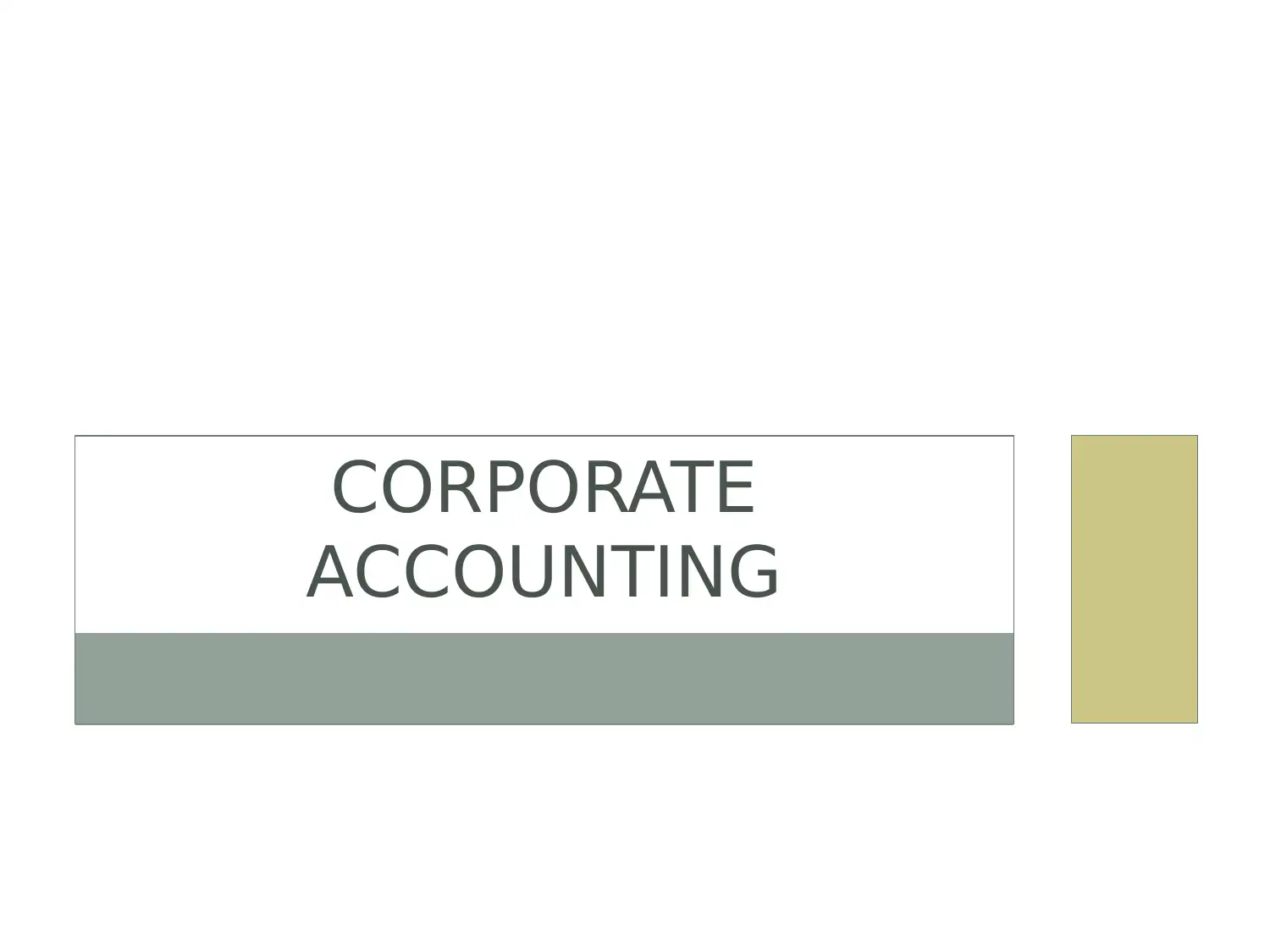
CORPORATE
ACCOUNTING
ACCOUNTING
Paraphrase This Document
Need a fresh take? Get an instant paraphrase of this document with our AI Paraphraser

TABLE OF CONTENTS
• Introduction
• Sources of Funds
• Evolution and Changes
• Internal and External Funds
• Merits and Demerits
• Liabilities and Assets classification
• AASB 137
• Measurement
• Conclusion
• References
• Introduction
• Sources of Funds
• Evolution and Changes
• Internal and External Funds
• Merits and Demerits
• Liabilities and Assets classification
• AASB 137
• Measurement
• Conclusion
• References
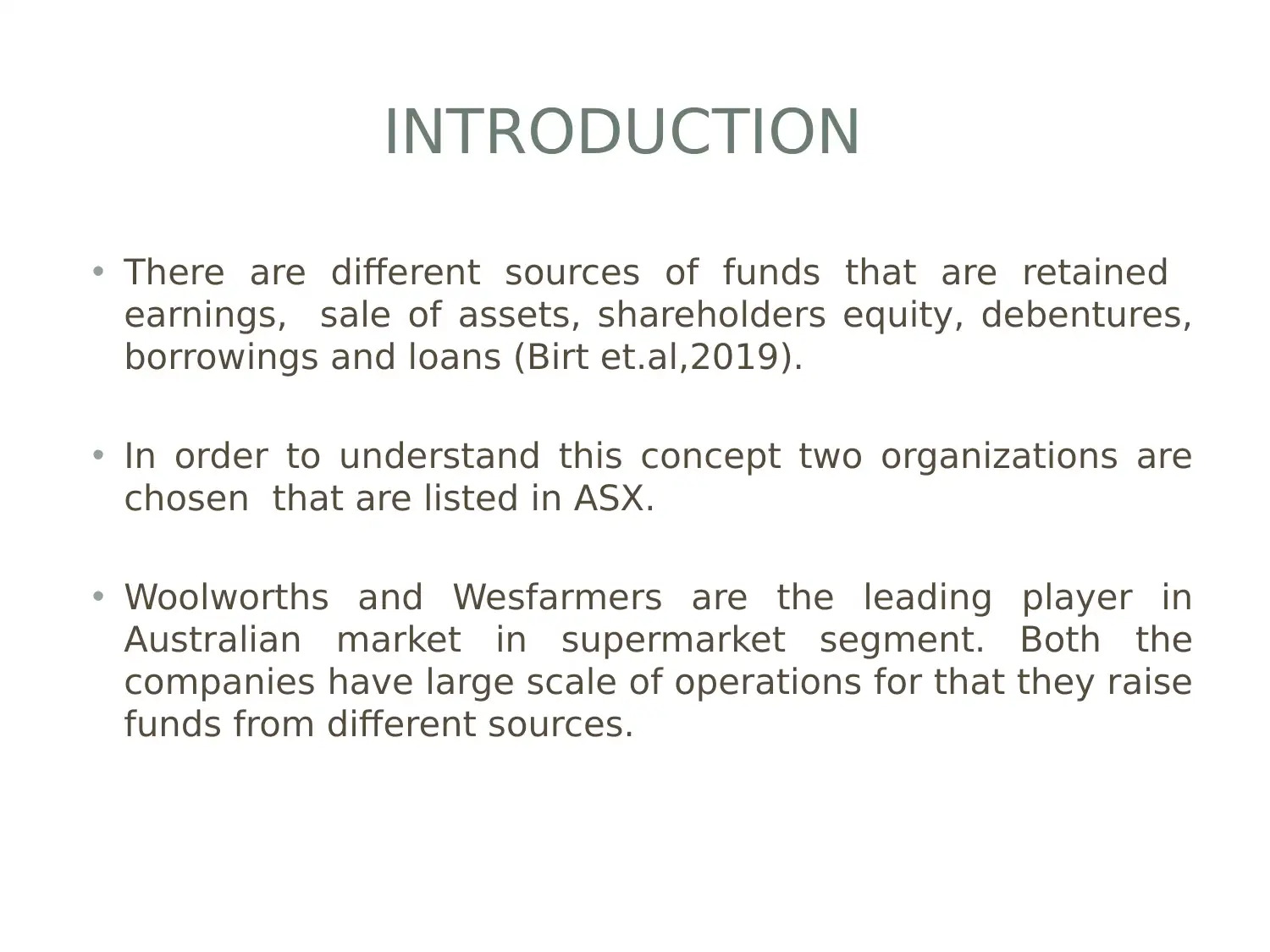
INTRODUCTION
• There are different sources of funds that are retained
earnings, sale of assets, shareholders equity, debentures,
borrowings and loans (Birt et.al,2019).
• In order to understand this concept two organizations are
chosen that are listed in ASX.
• Woolworths and Wesfarmers are the leading player in
Australian market in supermarket segment. Both the
companies have large scale of operations for that they raise
funds from different sources.
• There are different sources of funds that are retained
earnings, sale of assets, shareholders equity, debentures,
borrowings and loans (Birt et.al,2019).
• In order to understand this concept two organizations are
chosen that are listed in ASX.
• Woolworths and Wesfarmers are the leading player in
Australian market in supermarket segment. Both the
companies have large scale of operations for that they raise
funds from different sources.
⊘ This is a preview!⊘
Do you want full access?
Subscribe today to unlock all pages.

Trusted by 1+ million students worldwide
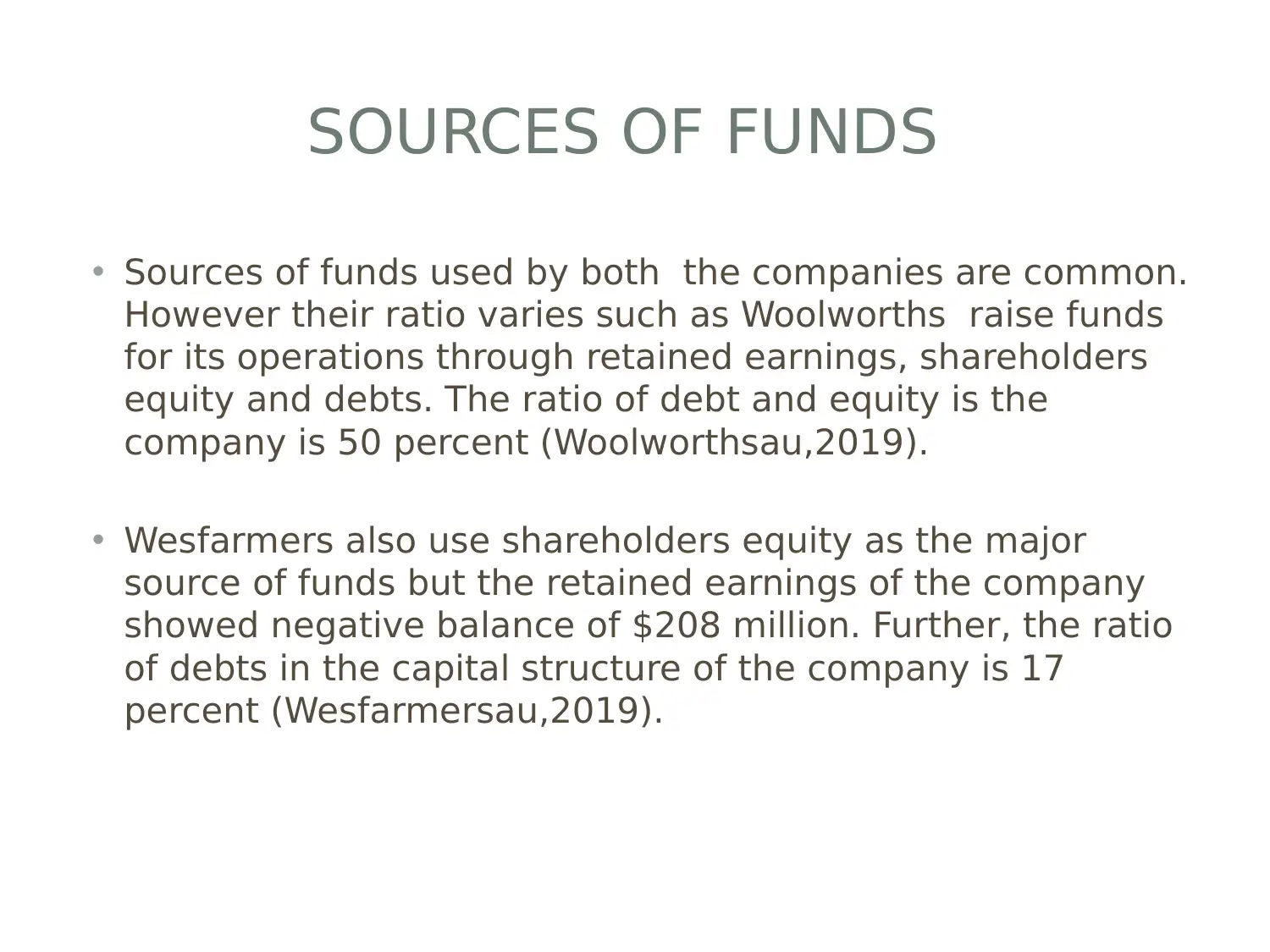
SOURCES OF FUNDS
• Sources of funds used by both the companies are common.
However their ratio varies such as Woolworths raise funds
for its operations through retained earnings, shareholders
equity and debts. The ratio of debt and equity is the
company is 50 percent (Woolworthsau,2019).
• Wesfarmers also use shareholders equity as the major
source of funds but the retained earnings of the company
showed negative balance of $208 million. Further, the ratio
of debts in the capital structure of the company is 17
percent (Wesfarmersau,2019).
• Sources of funds used by both the companies are common.
However their ratio varies such as Woolworths raise funds
for its operations through retained earnings, shareholders
equity and debts. The ratio of debt and equity is the
company is 50 percent (Woolworthsau,2019).
• Wesfarmers also use shareholders equity as the major
source of funds but the retained earnings of the company
showed negative balance of $208 million. Further, the ratio
of debts in the capital structure of the company is 17
percent (Wesfarmersau,2019).
Paraphrase This Document
Need a fresh take? Get an instant paraphrase of this document with our AI Paraphraser
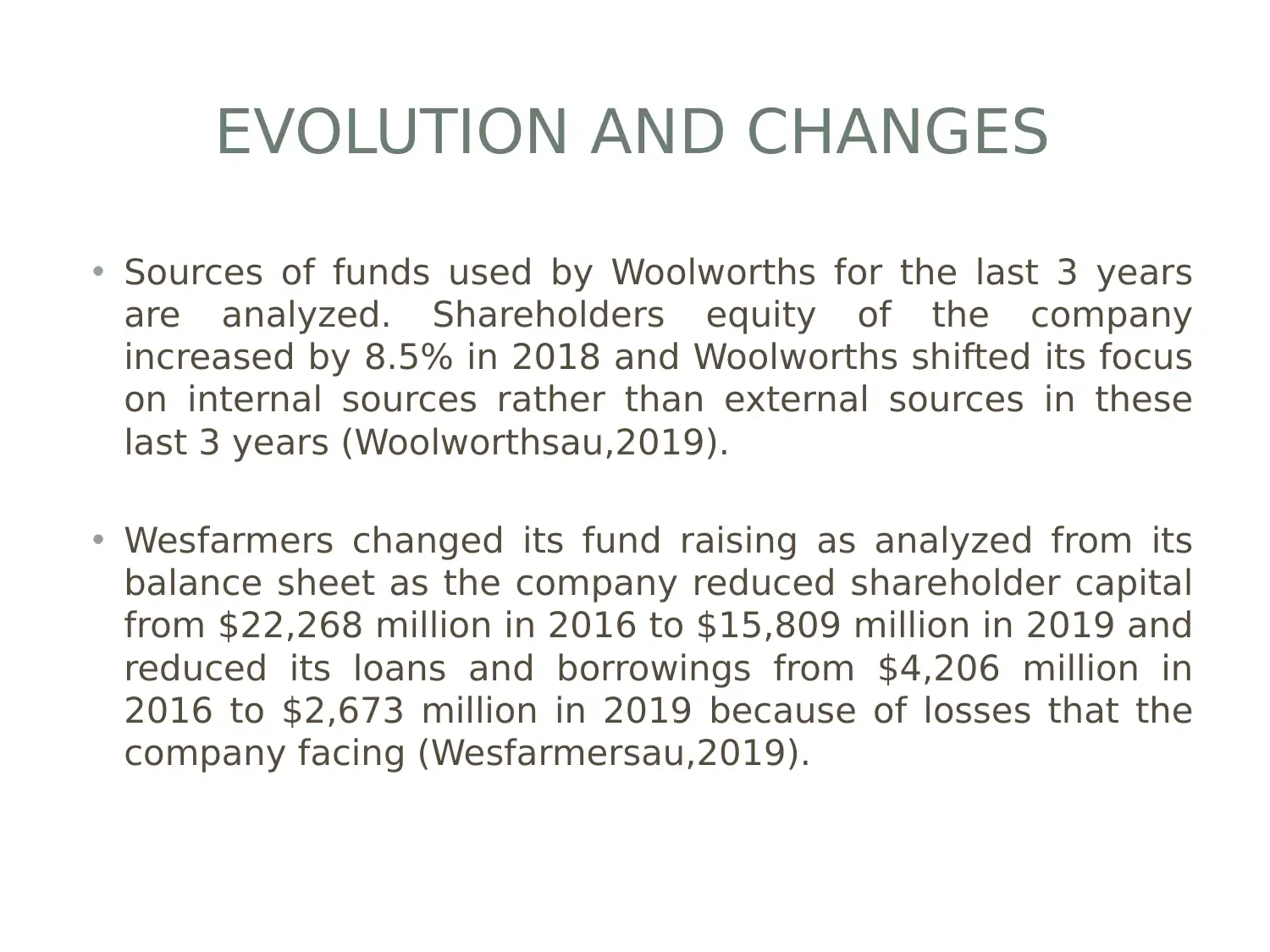
EVOLUTION AND CHANGES
• Sources of funds used by Woolworths for the last 3 years
are analyzed. Shareholders equity of the company
increased by 8.5% in 2018 and Woolworths shifted its focus
on internal sources rather than external sources in these
last 3 years (Woolworthsau,2019).
• Wesfarmers changed its fund raising as analyzed from its
balance sheet as the company reduced shareholder capital
from $22,268 million in 2016 to $15,809 million in 2019 and
reduced its loans and borrowings from $4,206 million in
2016 to $2,673 million in 2019 because of losses that the
company facing (Wesfarmersau,2019).
• Sources of funds used by Woolworths for the last 3 years
are analyzed. Shareholders equity of the company
increased by 8.5% in 2018 and Woolworths shifted its focus
on internal sources rather than external sources in these
last 3 years (Woolworthsau,2019).
• Wesfarmers changed its fund raising as analyzed from its
balance sheet as the company reduced shareholder capital
from $22,268 million in 2016 to $15,809 million in 2019 and
reduced its loans and borrowings from $4,206 million in
2016 to $2,673 million in 2019 because of losses that the
company facing (Wesfarmersau,2019).

INTERNAL AND EXTERNAL FUNDS
• Woolworths depend on both the sources for raising funds as
the company has balance structure.
• 45 percent of the funds are raised from internal sources and
55 percent of funds are raised from external sources that
are equity and debts.
• On the other side, Wesfarmers mainly depend on external
sources and in that mainly on shareholders equity, more
than half of the funds for the operations come from issuing
shares.
• Woolworths depend on both the sources for raising funds as
the company has balance structure.
• 45 percent of the funds are raised from internal sources and
55 percent of funds are raised from external sources that
are equity and debts.
• On the other side, Wesfarmers mainly depend on external
sources and in that mainly on shareholders equity, more
than half of the funds for the operations come from issuing
shares.
⊘ This is a preview!⊘
Do you want full access?
Subscribe today to unlock all pages.

Trusted by 1+ million students worldwide
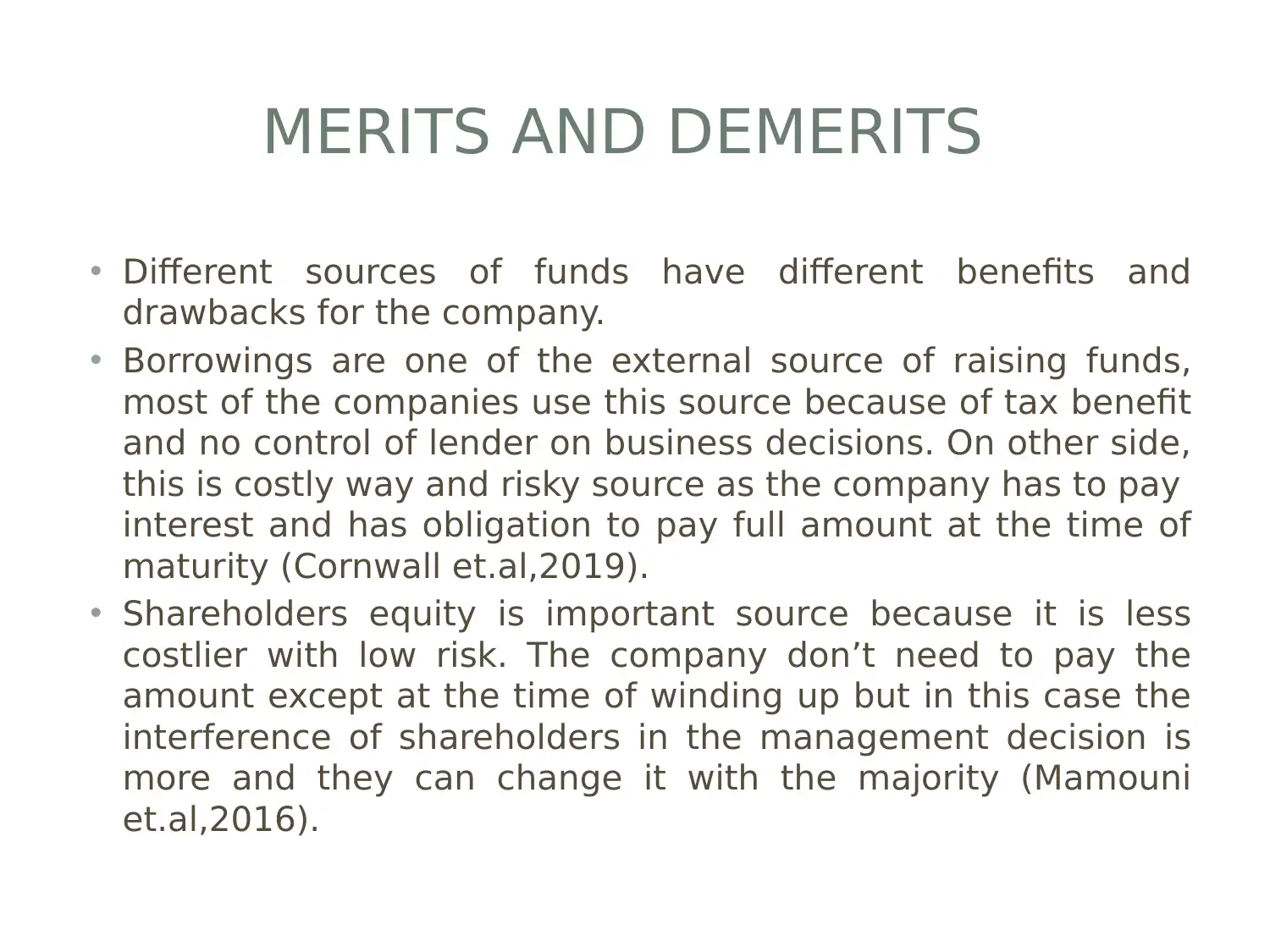
MERITS AND DEMERITS
• Different sources of funds have different benefits and
drawbacks for the company.
• Borrowings are one of the external source of raising funds,
most of the companies use this source because of tax benefit
and no control of lender on business decisions. On other side,
this is costly way and risky source as the company has to pay
interest and has obligation to pay full amount at the time of
maturity (Cornwall et.al,2019).
• Shareholders equity is important source because it is less
costlier with low risk. The company don’t need to pay the
amount except at the time of winding up but in this case the
interference of shareholders in the management decision is
more and they can change it with the majority (Mamouni
et.al,2016).
• Different sources of funds have different benefits and
drawbacks for the company.
• Borrowings are one of the external source of raising funds,
most of the companies use this source because of tax benefit
and no control of lender on business decisions. On other side,
this is costly way and risky source as the company has to pay
interest and has obligation to pay full amount at the time of
maturity (Cornwall et.al,2019).
• Shareholders equity is important source because it is less
costlier with low risk. The company don’t need to pay the
amount except at the time of winding up but in this case the
interference of shareholders in the management decision is
more and they can change it with the majority (Mamouni
et.al,2016).
Paraphrase This Document
Need a fresh take? Get an instant paraphrase of this document with our AI Paraphraser
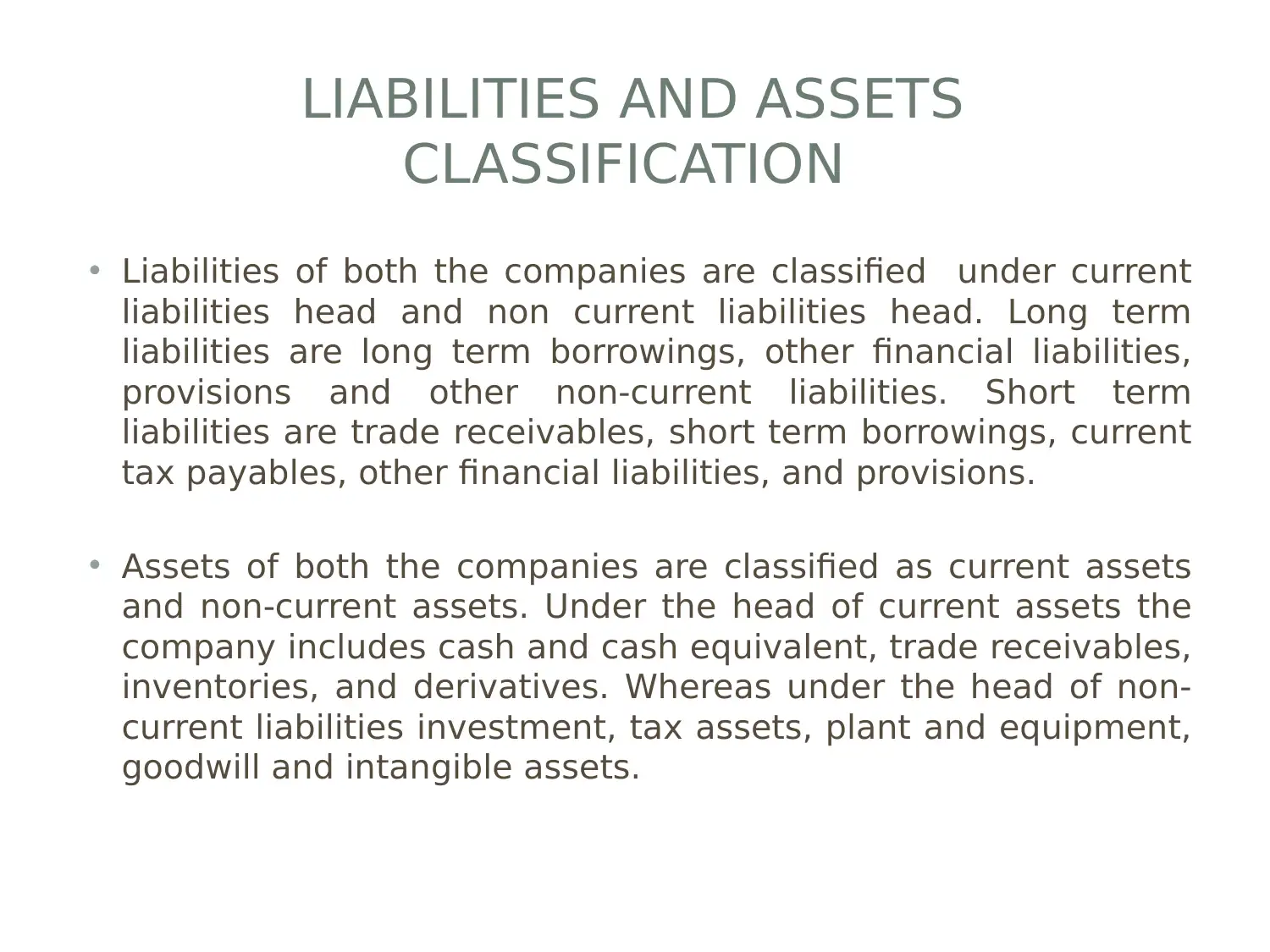
LIABILITIES AND ASSETS
CLASSIFICATION
• Liabilities of both the companies are classified under current
liabilities head and non current liabilities head. Long term
liabilities are long term borrowings, other financial liabilities,
provisions and other non-current liabilities. Short term
liabilities are trade receivables, short term borrowings, current
tax payables, other financial liabilities, and provisions.
• Assets of both the companies are classified as current assets
and non-current assets. Under the head of current assets the
company includes cash and cash equivalent, trade receivables,
inventories, and derivatives. Whereas under the head of non-
current liabilities investment, tax assets, plant and equipment,
goodwill and intangible assets.
CLASSIFICATION
• Liabilities of both the companies are classified under current
liabilities head and non current liabilities head. Long term
liabilities are long term borrowings, other financial liabilities,
provisions and other non-current liabilities. Short term
liabilities are trade receivables, short term borrowings, current
tax payables, other financial liabilities, and provisions.
• Assets of both the companies are classified as current assets
and non-current assets. Under the head of current assets the
company includes cash and cash equivalent, trade receivables,
inventories, and derivatives. Whereas under the head of non-
current liabilities investment, tax assets, plant and equipment,
goodwill and intangible assets.
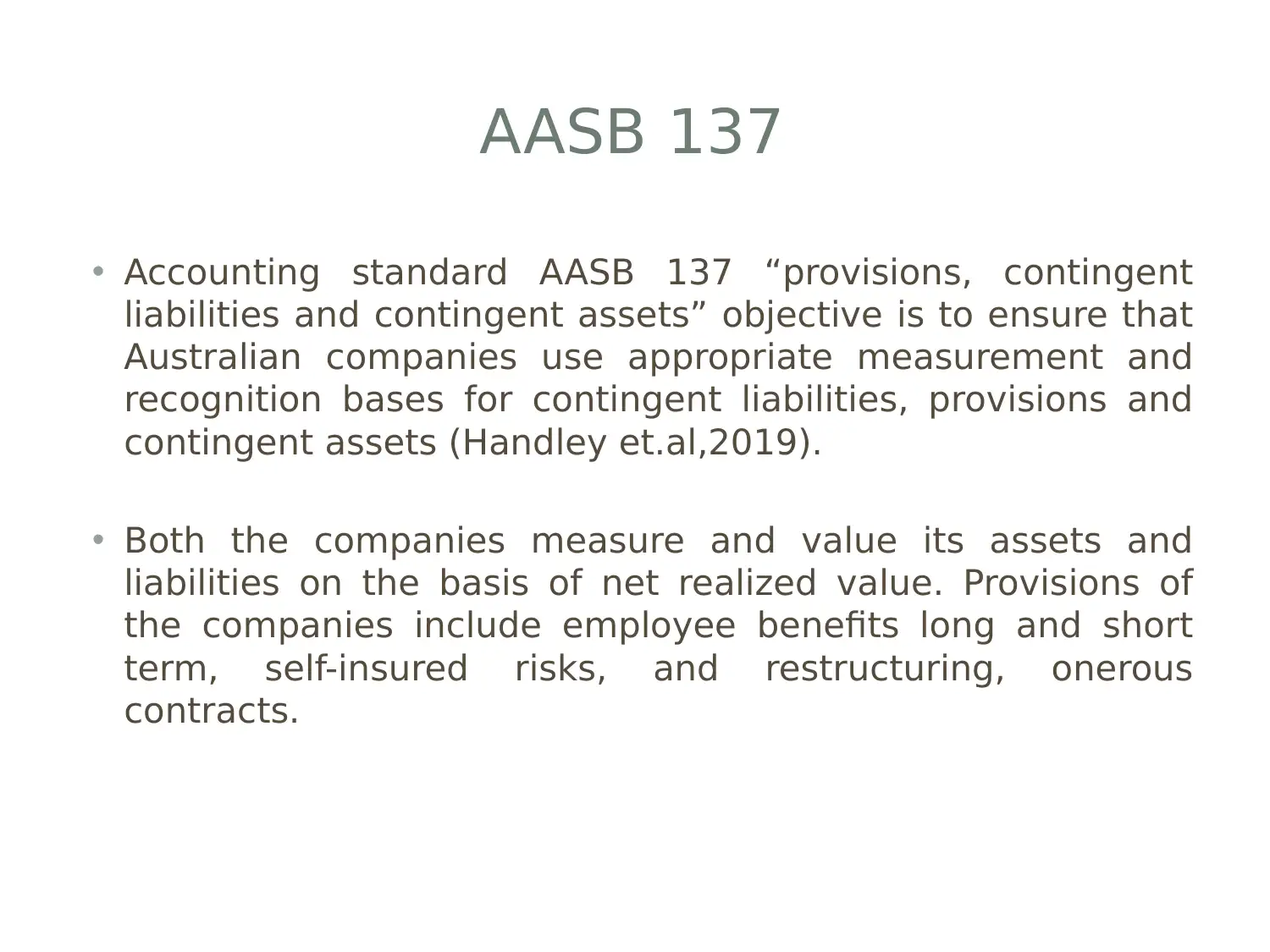
AASB 137
• Accounting standard AASB 137 “provisions, contingent
liabilities and contingent assets” objective is to ensure that
Australian companies use appropriate measurement and
recognition bases for contingent liabilities, provisions and
contingent assets (Handley et.al,2019).
• Both the companies measure and value its assets and
liabilities on the basis of net realized value. Provisions of
the companies include employee benefits long and short
term, self-insured risks, and restructuring, onerous
contracts.
• Accounting standard AASB 137 “provisions, contingent
liabilities and contingent assets” objective is to ensure that
Australian companies use appropriate measurement and
recognition bases for contingent liabilities, provisions and
contingent assets (Handley et.al,2019).
• Both the companies measure and value its assets and
liabilities on the basis of net realized value. Provisions of
the companies include employee benefits long and short
term, self-insured risks, and restructuring, onerous
contracts.
⊘ This is a preview!⊘
Do you want full access?
Subscribe today to unlock all pages.

Trusted by 1+ million students worldwide

MEASUREMENT
• Wesfarmers values its current assets on the basis of net
realizable value. The company measure its raw material on
the basis of the purchase cost on a weighted average
basis . Goodwill and intangible assets are measured at cost,
and the cost is measured as “the cost of business
combination minus the net fair value of contingent liabilities
and identifiable assets (Wesfarmersau,2019).
• Woolworths value its inventories as net realizable value,
and at the reporting date, all stock is valued at the cost.
Further, the group adopted Australian standard AASB 15,
AASB 9 and AASB 16 for measuring its leases and revenue
from contracts (Woolworthsau,2019).
• Wesfarmers values its current assets on the basis of net
realizable value. The company measure its raw material on
the basis of the purchase cost on a weighted average
basis . Goodwill and intangible assets are measured at cost,
and the cost is measured as “the cost of business
combination minus the net fair value of contingent liabilities
and identifiable assets (Wesfarmersau,2019).
• Woolworths value its inventories as net realizable value,
and at the reporting date, all stock is valued at the cost.
Further, the group adopted Australian standard AASB 15,
AASB 9 and AASB 16 for measuring its leases and revenue
from contracts (Woolworthsau,2019).
Paraphrase This Document
Need a fresh take? Get an instant paraphrase of this document with our AI Paraphraser
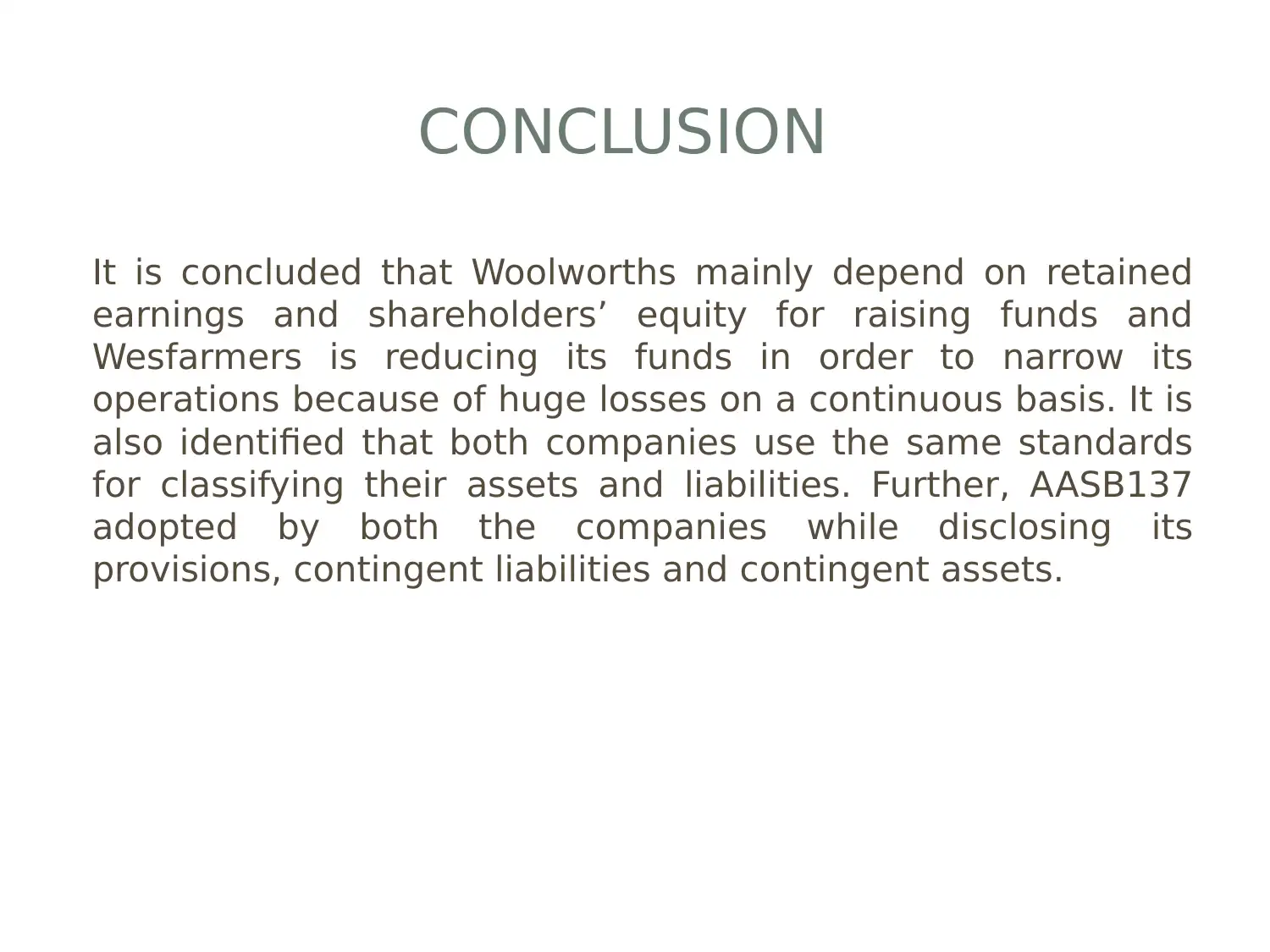
CONCLUSION
It is concluded that Woolworths mainly depend on retained
earnings and shareholders’ equity for raising funds and
Wesfarmers is reducing its funds in order to narrow its
operations because of huge losses on a continuous basis. It is
also identified that both companies use the same standards
for classifying their assets and liabilities. Further, AASB137
adopted by both the companies while disclosing its
provisions, contingent liabilities and contingent assets.
It is concluded that Woolworths mainly depend on retained
earnings and shareholders’ equity for raising funds and
Wesfarmers is reducing its funds in order to narrow its
operations because of huge losses on a continuous basis. It is
also identified that both companies use the same standards
for classifying their assets and liabilities. Further, AASB137
adopted by both the companies while disclosing its
provisions, contingent liabilities and contingent assets.
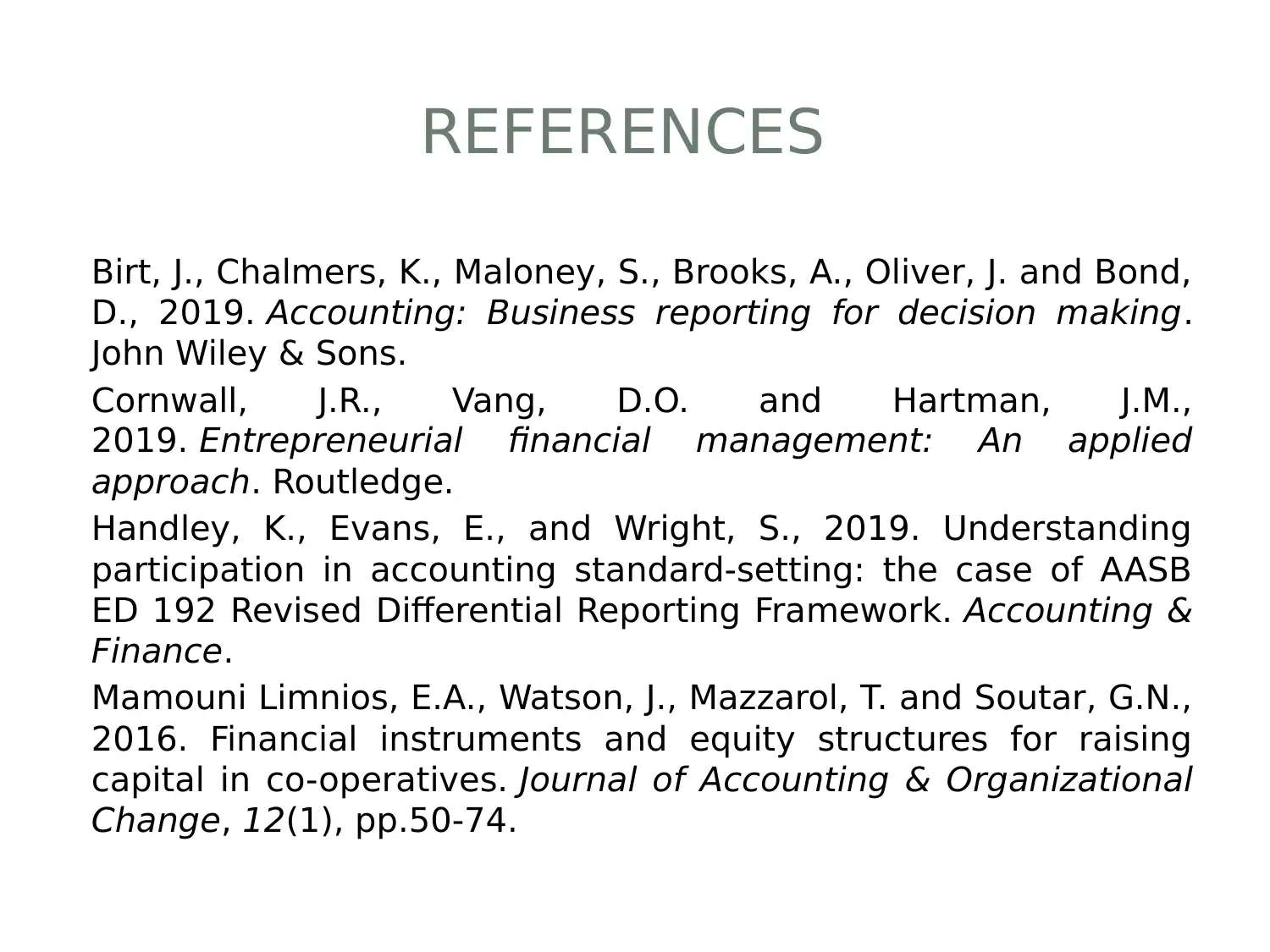
REFERENCES
Birt, J., Chalmers, K., Maloney, S., Brooks, A., Oliver, J. and Bond,
D., 2019. Accounting: Business reporting for decision making.
John Wiley & Sons.
Cornwall, J.R., Vang, D.O. and Hartman, J.M.,
2019. Entrepreneurial financial management: An applied
approach. Routledge.
Handley, K., Evans, E., and Wright, S., 2019. Understanding
participation in accounting standard‐setting: the case of AASB
ED 192 Revised Differential Reporting Framework. Accounting &
Finance.
Mamouni Limnios, E.A., Watson, J., Mazzarol, T. and Soutar, G.N.,
2016. Financial instruments and equity structures for raising
capital in co-operatives. Journal of Accounting & Organizational
Change, 12(1), pp.50-74.
Birt, J., Chalmers, K., Maloney, S., Brooks, A., Oliver, J. and Bond,
D., 2019. Accounting: Business reporting for decision making.
John Wiley & Sons.
Cornwall, J.R., Vang, D.O. and Hartman, J.M.,
2019. Entrepreneurial financial management: An applied
approach. Routledge.
Handley, K., Evans, E., and Wright, S., 2019. Understanding
participation in accounting standard‐setting: the case of AASB
ED 192 Revised Differential Reporting Framework. Accounting &
Finance.
Mamouni Limnios, E.A., Watson, J., Mazzarol, T. and Soutar, G.N.,
2016. Financial instruments and equity structures for raising
capital in co-operatives. Journal of Accounting & Organizational
Change, 12(1), pp.50-74.
⊘ This is a preview!⊘
Do you want full access?
Subscribe today to unlock all pages.

Trusted by 1+ million students worldwide
1 out of 13
Related Documents
Your All-in-One AI-Powered Toolkit for Academic Success.
+13062052269
info@desklib.com
Available 24*7 on WhatsApp / Email
![[object Object]](/_next/static/media/star-bottom.7253800d.svg)
Unlock your academic potential
Copyright © 2020–2025 A2Z Services. All Rights Reserved. Developed and managed by ZUCOL.





